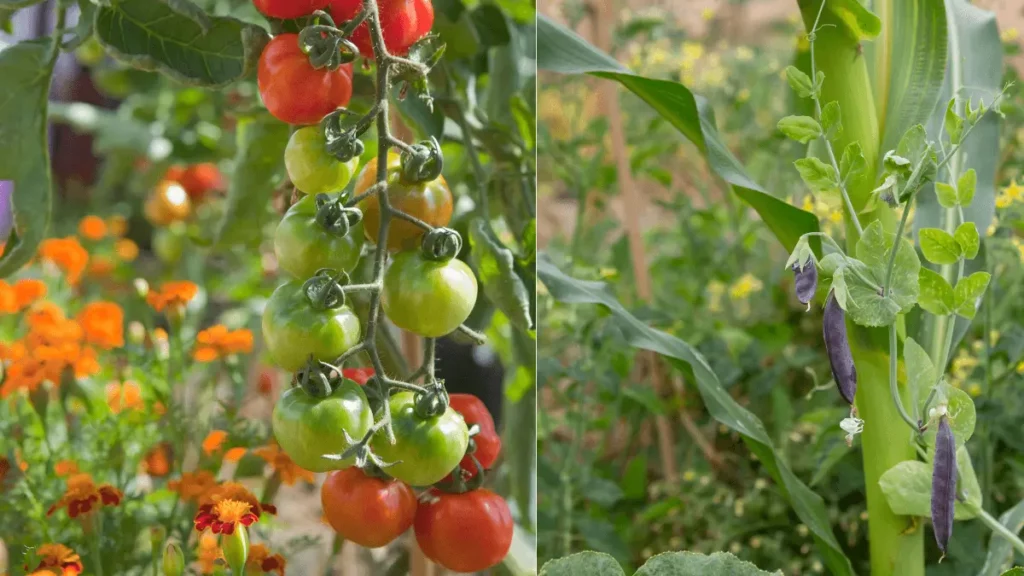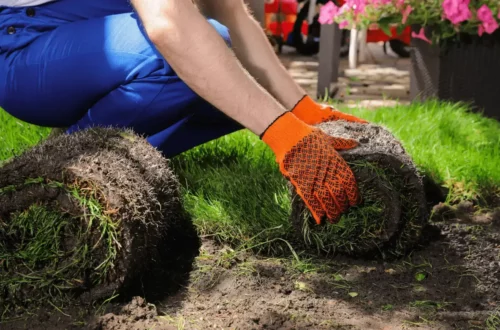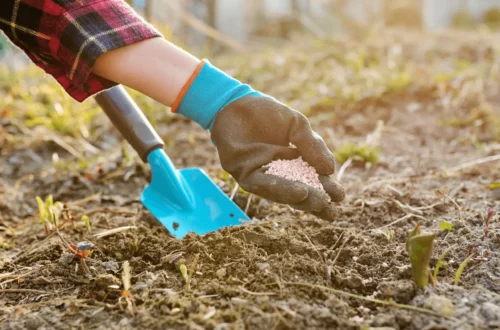The Ultimate Guide to Companion Planting for a Thriving Garden

Are you tired of dealing with pests and struggling to get your garden to thrive? Imagine a garden filled with healthy, beautiful plants that not only repel pests but also attract beneficial pollinators. It may sound too good to be true, but with companion planting, it’s possible.
Companion planting is the practice of strategically pairing vegetable varieties to create a mutually beneficial environment in your garden. It’s like the ultimate buddy system for plants. Some plants repel pests, while others provide shade or attract pollinators. By harnessing the power of companion planting, you can create a thriving garden that works in harmony with nature.
In this ultimate guide to companion planting, we’ll explore everything you need to know to transform your garden into a lush, pest-resistant paradise. From the benefits of companion planting to practical tips for pairing different vegetable varieties, we’ve got you covered. We’ll also discuss common mistakes to avoid and provide examples of successful plant combinations.
Get ready to unlock the secrets of companion planting and discover how to create a garden that not only looks beautiful but also supports a healthy ecosystem. It’s time to say goodbye to pesky pests and hello to a thriving garden. Let’s dig in!
What Is Companion Planting?
Companion planting refers to the strategic arrangement of different plant species in close proximity, where they mutually benefit each other in various ways. This gardening technique is based on the idea that certain plants, when grown together, can enhance each other’s growth, health, and productivity.
The basic principles of companion planting involve selecting compatible plants that have complementary growth habits, nutritional needs, and pest deterrent properties. By planting specific combinations of vegetables, herbs, and flowers, gardeners can create a harmonious ecosystem that promotes natural pest control, maximizes pollination, improves soil fertility, and provides shade and protection against harsh weather conditions.
Companion planting is not only about which plants grow well together, but it also takes into consideration the timing and spacing of plantings to optimize their interaction and symbiotic relationship. For instance, taller plants can provide shade to more delicate varieties, while certain flowers attract beneficial insects to combat common garden pests.
By adopting companion planting techniques in your vegetable garden, you can create a thriving and balanced ecosystem that promotes the health and productivity of your plants while reducing the need for chemical fertilizers and pesticides.
Remember, successful companion planting requires careful consideration of plant compatibility, growing conditions, and proper maintenance. In the following sections, we will dive deeper into the benefits of companion planting and provide you with valuable insights on selecting companion plants that deter pests, provide shade, and attract pollinators.
Also read: A Complete Guide to Year-Round Vegetable Gardening: 10 Steps for Success
Benefits of Companion Planting
Companion planting offers a multitude of benefits for your vegetable garden. By strategically pairing plants, you can create a harmonious environment that promotes pest control, enhances soil quality, and improves overall plant health.
Pest Control: Certain plant combinations have the power to naturally repel pests. For example, marigolds emit a scent that deters aphids and nematodes, while garlic acts as a natural insecticide against cabbage worms and spider mites. By incorporating these companion plants, you can significantly reduce the need for chemical pesticides.
Enhanced Soil Quality: Companion plants also play a vital role in improving soil health. Legumes, like beans and peas, have the unique ability to fix nitrogen from the air and convert it into a form that other plants can readily absorb. This nitrogen enrichment boosts soil fertility and provides essential nutrients to neighboring plants.
Improved Plant Health: Companion planting can enhance the overall health and vigor of your vegetable garden. For instance, the combination of basil and tomatoes not only deters pests but also improves the flavor and the yield of both plants. Additionally, taller plants can provide shade and protection to smaller, more delicate plants, preventing sunburn and reducing water evaporation.
By embracing companion planting techniques, you can create a thriving ecosystem within your garden, promoting natural pest control, boosting soil fertility, and ensuring the overall health and productivity of your vegetable plants.
Also read: A Comprehensive Guide to Organic Gardening for Newbies
Companion Plants That Deter Pests
In a vegetable garden, companion plants can play a crucial role in deterring common pests and promoting plant health. By strategically pairing vegetables with certain companion plants, you can create a natural defense system that reduces the need for harmful pesticides. Here are some specific companion plants that have been proven to deter pests:
1. Marigolds – Marigolds emit a strong scent that repels many garden pests, including aphids, nematodes, and whiteflies. Plant marigolds alongside vegetables like tomatoes, peppers, and cucumbers to keep these pests at bay.
2. Basil – Besides being a flavorful herb, basil also acts as a companion plant that repels mosquitoes, flies, and tomato hornworms. Plant basil near tomatoes, peppers, and lettuce to protect them from these pests.
3. Nasturtiums – Nasturtiums attract aphids away from your vegetables, making them excellent companions for crops like radishes, cucumbers, and cabbage. Additionally, nasturtiums repel squash bugs and striped pumpkin beetles.
4. Chives – Chives not only add a burst of flavor to dishes but also help deter aphids, Japanese beetles, and carrot flies. Plant chives near carrots, tomatoes, and broccoli to protect them from these common pests.
Remember to interplant these companion plants strategically throughout your vegetable garden to maximize their pest-repelling benefits. By incorporating companion plants that deter pests, you can create a healthier ecosystem and reduce the risks associated with chemical pesticides.
Companion Plants That Provide Shade
In a vegetable garden, providing shade for sensitive plants is essential to regulate soil temperature and protect them from harsh sun exposure. Here are some companion plants that can help create a shaded environment for your delicate vegetables:
1. Sunflowers
Sunflowers are not only beautiful additions to your garden but also effective shade providers. Their tall, sturdy stalks and large leaves create a natural canopy that shields smaller vegetables from the intense sunlight. Plant sunflowers strategically on the south or west side of your vegetable beds to cast shade during the hottest parts of the day.
2. Nasturtiums
Nasturtiums are versatile companion plants that not only add vibrant colors to your garden but also provide ample shade. Their sprawling, low-growing habit creates a living groundcover, protecting the soil and providing shade for neighboring plants. Plus, nasturtiums release compounds that repel certain pests, making them excellent companions for sensitive vegetables.
3. Buckwheat
Buckwheat is a fast-growing plant that can quickly fill in spaces and provide shade for tender vegetables. Its dense foliage helps keep the soil cool and moist, while also attracting beneficial insects. Consider planting buckwheat as a temporary cover crop or in between rows of vegetables to create shade while enriching the soil with organic matter.
Remember to choose companion plants that have compatible growth habits and can thrive in your growing conditions. By incorporating these shade-providing companions into your garden, you can create a more comfortable microclimate for your sensitive vegetables and enhance their overall growth and productivity.
Also read: Creating a Pollinator Garden: 10 Essential Tips
Companion Plants That Attract Pollinators
Attracting pollinators to your vegetable garden is essential for ensuring a bountiful harvest. By planting companion plants that attract bees, butterflies, and other beneficial insects, you can significantly increase the pollination of your vegetable plants. Here are some excellent companion plants to consider:
1. Lavender (Lavandula spp.): The fragrant blooms of lavender are irresistible to bees and butterflies, making it an excellent choice for attracting pollinators to your garden. Plus, its beautiful purple flowers add a touch of elegance.
2. Borage (Borago officinalis): Borage is not only a stunning addition to your garden with its vibrant blue flowers, but it also acts as a magnet for bees. This plant is known to produce abundant nectar, attracting a range of pollinators.
3. Sunflowers (Helianthus spp.): Sunflowers are a favorite of bees and provide them with a plentiful source of nectar. Their large, bright yellow flowers are not only visually appealing but also highly attractive to pollinators.
4. Calendula (Calendula officinalis): Calendula’s cheerful yellow and orange flowers make it an attractive addition to any garden. Bees and butterflies are particularly drawn to this plant, making it an excellent choice for increasing pollinator activity.
5. Lupine (Lupinus spp.): Lupine flowers come in a range of vibrant colors, including purple, pink, and yellow. Not only do they add beauty to your garden, but they also attract bees, butterflies, and hummingbirds.
Remember to plant these companion plants near your vegetable crops to maximize their pollination benefits. By providing an abundant source of nectar and attracting pollinators, you’ll enjoy higher yields and a thriving vegetable garden.
Also read: How to Grow a Sustainable Garden: A Beginner’s Guide
Common Companion Planting Mistakes
Companion planting is a valuable technique in the vegetable garden, but it’s important to be aware of the common mistakes that can hinder its effectiveness. By avoiding these pitfalls, you can maximize the benefits of companion planting and create a thriving garden. Here are some common mistakes made by gardeners and tips on how to avoid them:
1. Planting Incompatible Plants Together
One of the most critical errors is pairing incompatible plants. Some plants release compounds that can inhibit the growth of others, leading to poor performance or stunted growth. Research plant compatibility before planning your garden and ensure that the plants you choose are good companions.
2. Overcrowding Plants
Planting too closely together can lead to competition for resources like sunlight, water, and nutrients. It’s crucial to give each plant enough space to grow and flourish. Follow spacing guidelines and consider the mature size of each plant when determining how far apart to plant them.
3. Neglecting Soil and Nutrient Needs
Different plants have different soil and nutrient requirements. Neglecting these needs can result in nutrient imbalances and poor growth. Before planting, make sure you understand the soil and nutrient requirements of each plant and amend the soil accordingly.
4. Ignoring Pest and Disease Prevention
Companion planting can help deter pests and diseases, but ignoring pest and disease prevention measures can undermine the effectiveness of companion plants. Regularly inspect your garden for pests and diseases, and take prompt action to address any issues that arise.
5. Failing to Rotate Crops
Crop rotation is essential for preventing the buildup of pests and diseases that affect specific plant families. Ensure that you rotate crops regularly, aiming for a three-year cycle. This practice helps maintain soil health and reduces the risk of plant-related issues.
6. Not Considering Plant Growth Habits
Each plant has a unique growth habit, including height, spread, and root system. Failure to consider these factors can lead to overcrowding, shading, or root competition. Plan your garden layout with attention to the growth habits of each plant to ensure optimal growing conditions.
7. Disregarding Plant Timing
Timing plays a crucial role in companion planting. Some plants may require different growing seasons or have different sun and shade preferences. Ignoring these factors can result in plants not receiving the ideal conditions for growth and productivity.
Also read: Budget-Friendly Garden Makeover: Creative Ideas for a Stunning Outdoor Space
By avoiding these common companion planting mistakes, you can create a harmonious and productive garden. Keep in mind the individual needs and compatibility of the plants you choose, and regularly monitor and address any issues that arise. With proper planning and care, you can achieve a successful companion planting garden.





